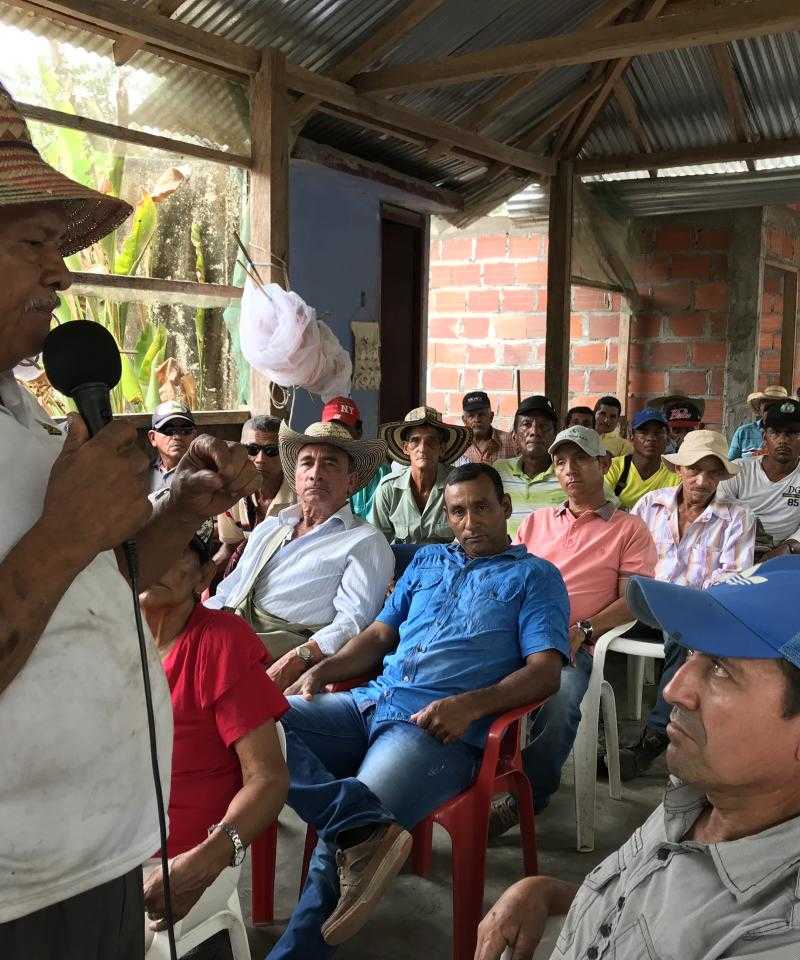El Garzal: a Colombian peasant community's 40 years of resistance

The following article explores the experience of the El Garzal community, in the South of Bolívar in Colombia, and is based on the presentation made by Pastor Salvador Alcántara during the WRI "Antimilitarism in Movement" Conference.
Land ownership and its concentration has been part of the history of the Colombian armed conflict. Historically, peasant, indigenous and Afro-descendant communities have denounced the unequal distribution and dispossession of land, and have demanded decent access to land.
Different attempts of agrarian reform have unsuccessfully tried to redistribute rural property, that has become concentrated in a few sectors of Colombian society. In the meantime, actors in the armed conflict have appropriated land, increasing the concentration of its ownership to just a few individuals and leaving millions of victims along the way.
Many rural communities in our country have suffered state violence, corruption, indifference and abandonment. One of example of this is found in the South of Bolívar, in the municipality of Simití: the community of El Garzal, which is currently home to more than 300 families who claim ownership over state lands that they have been working for two generations.
More than 40 years ago, families from the departments of Bolívar, Cesar, Córdoba and Santander came to El Garzal to settle mainly on nearly 4,000 hectares of wasteland owed by the state, and dedicated themselves to agricultural production and livestock, sustainability and family food security with crops of corn, cocoa, banana, rice, cassava, avocado, mango, among others. The rest of the land of El Garzal, which amounts to about 15,000 hectares, is made up of savannas, beaches and seven marshes and wetlands.
During the 1980s and the mid-90s, the National Liberation Army (ELN) and the Revolutionary Armed Forces of Colombia - People's Army (FARC-EP) had total control of southern Bolivar. In this context, Manuel Enrique Barreto arrived in the region. He was later linked to the illicit activities of the Bolívar Central Block of the United Self-Defense Forces of Colombia (AUC), which sought to obtain full control over the community's lands. Because of his activities related to drug trafficking Barreto left the south of Bolívar at the end of the 1980's, and there was no news of his whereabouts for almost a decade.
The community of El Garzal has been the victim of forced displacement, extortion and threats from groups wanting to deprive them of the land they have dedicated more than half a century to in order to provide sustainable food for their families. The groups threatening the community want to use it for for their own economic benefit through intensive livestock farming, monocultures and extractivism. These facts have been documented by the Ombudsman's Office1 and made known to local authorities.
Between the end of 2003 and the beginning of 2004, the threats of dispossession became daily occurences again. Comments were made to the community that Manuel Enrique Barreto would enter El Garzal to draw blood and attack those he considered to be invaders of their lands. In this scenario, the figure of Salvador Alcántara, Pastor of the Foursquare Church of El Garzal, became relevant. Alcántara became the leader of a process of peaceful resistance through faith to these warnings.
Finding strength in their faith, the peasants remained on their lands knowing that at any moment they could be banished. Some who did not belong to the church preferred to safeguard their lives by leaving the township. Others, seeing the determination of the Pastor and the church members, joined together to face the threat.
However, these have not been the only means to try to strip rural families of El Garzal from their lands. Since 2004, Manuel Enrique Barreto, his successors and his allies have filed various judicial and administrative actions in order to prevent the State from handing ownership of land to the peasants of El Garzal. The legal uncertainty that these actions have generated has meant that these families do not currently own the land they have worked for so many years, and also prevents them from having access to essential public services such as drinking water and electricity, as well as to agricultural subsidies that can ensure food security and economic sustainability.
The process of peaceful resistance to violence and the organization of the community around the objective of having their rights over the land they have worked and taken care of has been accompanied by national organizations such as Justapaz and international organizations such as Equipos Cristianos de Acción por la Paz - ECAP and Peace Watch Switzerland.
After years of peaceful resistance and as a light of hope for the inaction of the State for so many years, the Constitutional Court will review a guardianship action filed by the community in 2018, with which the peasants requested the protection of their rights to the land, to the territory, to human dignity, to work, to submit requests, to access information and to administrative processes.
The Constitutional Court is expected to protect the rights of the community and order the agrarian authority, today known as the National Land Agency (ANT), to respond to its claims for land, within a reasonable time and without undue delay.
Meanwhile, with the strength of the Magdalena River, this organized and peaceful community will continue with the exercise of resistance from faith, demanding and claiming their rights. El Garzal, like hundreds of rural and ethnic communities, will continue to demand respect for life and guarantee of fundamental rights as tools for building a culture of peace in Colombia.
1 Ombudsman's Office. Early Warning System, Risk Reports No. 010 - 04 AI of February 26, 2004; No. 015 - 07 AI of June 15, 2007; No. 0188-011 of December 9, 2011; No. 008 - 12 AI of June 22, 2012.
Add new comment